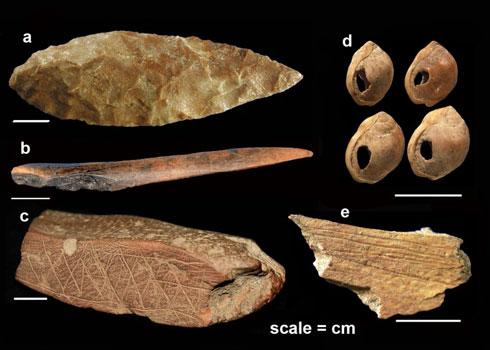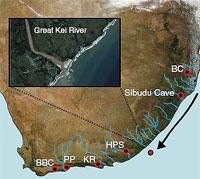Natural History Museum
Source - http://phys.org/news/2013-05-human-culture-linked-rapid-climate.html

Signs of modern human culture - symbolic artefacts from around 75,000 years ago unearthed from Still Bay at Blombos Cave, South Africa: a) bifacial foliate point, b) bone tool, c) engraved ochre, d) shell beads, e) engraved bone. Credit: Christopher Henshilwood
We moan about the wet weather all too often but it may have been crucial in the development of human culture from about 70,000 years onwards, according to scientists reporting in Nature Communications today.
Some of the earliest signs of modern human culture, found in South African archaeological sites from that time, are linked to periods where the climate changed rapidly to wetter conditions, scientists say.
A team led by Martin Ziegler at the School of Earth and Ocean Sciences at Cardiff University and including those at the Natural History Museum and the University of Barcelona, studied a marine sediment core from the coast of South Africa and reconstructed climate variability on land over the last 100,000 years.
During that time, the Northern Hemisphere had phases of extreme cooling, while northern sub-Saharan Africa experienced widespread droughts, and it was often assumed that southern Africa did too. This research suggests, however, that South Africa, rather than being the same as sub-Saharan Africa, responded in the opposite direction with increased rainfall.
The new research shows that known periods of early modern human cultural innovation coincided with brief phases of increased rainfall and humidity between 80,000 and 40,000 years ago, during the Middle Stone Age. Some of these climate switches were very rapid, occurring in decades rather than centuries.
Modern human behaviour
South African archaeological records show some of the oldest evidence for modern human (Homo sapiens) behaviours, suggesting the presence of complex language, innovation and cultural identity. Symbolic expression through engravings, tools and jewellery have been unearthed from sites dated to over 60,000 years old.
What drives inventiveness?
Professor Chris Stringer of the Natural History Museum, who was part of the research team says, 'There is currently much debate about what drives inventiveness in human groups - is it environmental stress, forcing people to innovate to survive, or is it actually improved and stable conditions?

Archaeological sites in South Africa {Blombos Cave (BBC), Pinnacle Point (PP), Klasies river (KR), Howiesons Poort Shelter (HPS), Sibudu Cave (SC) and Border Cave (BC)}. These sites have evidence of cultural innovations from over 60,000 years ago. Site of marine sediment core (red dot with arrow) studied in this research.
'Some recent research suggests that human populations require a certain minimum level of density and networking between neighbouring groups, or cultural knowledge will actually be lost, rather than gained, through time. The opposite will occur if populations are relatively dense and interacting, as ideas can be built on, with more chance of being conserved.
'The correspondence we find between climatic ameliorations and cultural innovations supports the view that improved climate fuelled population growth, in turn catalysing cultural changes through increased human interactions.
'The quality of the southern African data allowed us to make these correlations between climate and behavioural change, but it will require comparable data from other areas before we can say whether this region was uniquely important in the development of modern human culture.
Stringer concludes, 'Personally, I think that various areas of the continent contributed to the formation of our species, before we began to spread from Africa about 60,000 years ago.'
The paper is titled "Development of Middle Stone Age innovation linked to rapid climate change."